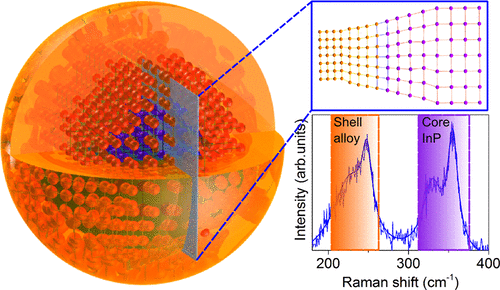当前位置:
X-MOL 学术
›
Chem. Mater.
›
论文详情
Our official English website, www.x-mol.net, welcomes your
feedback! (Note: you will need to create a separate account there.)
Strain Engineering in InP/(Zn,Cd)Se Core/Shell Quantum Dots
Chemistry of Materials ( IF 7.2 ) Pub Date : 2018-06-12 00:00:00 , DOI: 10.1021/acs.chemmater.8b01789
Mona Rafipoor 1, 2 , Dorian Dupont 3 , Hans Tornatzky 4 , Mickael D. Tessier 3 , Janina Maultzsch 4 , Zeger Hens , Holger Lange 1, 2
Chemistry of Materials ( IF 7.2 ) Pub Date : 2018-06-12 00:00:00 , DOI: 10.1021/acs.chemmater.8b01789
Mona Rafipoor 1, 2 , Dorian Dupont 3 , Hans Tornatzky 4 , Mickael D. Tessier 3 , Janina Maultzsch 4 , Zeger Hens , Holger Lange 1, 2
Affiliation

|
The formation of core/shell structures has become an established approach to passivate the surface and enhance the photoluminescence quantum yield of semiconductor nanocrystals, quantum dots. However, lattice mismatch between the core and the shell materials results in surface reconstructions at the core/shell interface and compressive or tensile strain in the core and the shell. Concomitantly formed surface traps can have a negative impact on the emission properties. Growing buffer layers with intermediate lattice constants or using alloys to tune the lattice constant is often considered to reduce the reconstruction-induced strain. We present a study that quantitatively relates strain and shell composition in the case of InP/(Zn,Cd)Se core/shell quantum dots. We apply Raman spectroscopy to quantize strain and find that adjusting the composition of the (Zn,Cd)Se shell tunes the strain from compressive to tensile. The transition between both regimes is found at shell compositions where the bulk lattice constants of InP and (Zn,Cd)Se match, which confirms that matching lattice constants is a viable strategy to achieve strain-free core/shell nanocrystals.
中文翻译:

InP /(Zn,Cd)Se核/壳量子点中的应变工程
核/壳结构的形成已成为钝化表面并提高半导体纳米晶体量子点的光致发光量子产率的成熟方法。然而,核和壳材料之间的晶格失配导致核/壳界面处的表面重构以及核和壳中的压缩应变或拉伸应变。随之形成的表面陷阱可能会对发射特性产生负面影响。通常考虑增加具有中间晶格常数的缓冲层或使用合金来调整晶格常数,以减少重建引起的应变。我们提出了在InP /(Zn,Cd)Se核/壳量子点的情况下定量关联应变和壳组成的研究。我们应用拉曼光谱法来量化应变,并发现调整(Zn,Cd)Se壳的成分可以将应变从压缩应变调整为拉伸应变。两种状态之间的过渡是在壳成分中发现的,其中InP和(Zn,Cd)Se的整体晶格常数匹配,这证实了匹配晶格常数是实现无应变核/壳纳米晶体的可行策略。
更新日期:2018-06-12
中文翻译:

InP /(Zn,Cd)Se核/壳量子点中的应变工程
核/壳结构的形成已成为钝化表面并提高半导体纳米晶体量子点的光致发光量子产率的成熟方法。然而,核和壳材料之间的晶格失配导致核/壳界面处的表面重构以及核和壳中的压缩应变或拉伸应变。随之形成的表面陷阱可能会对发射特性产生负面影响。通常考虑增加具有中间晶格常数的缓冲层或使用合金来调整晶格常数,以减少重建引起的应变。我们提出了在InP /(Zn,Cd)Se核/壳量子点的情况下定量关联应变和壳组成的研究。我们应用拉曼光谱法来量化应变,并发现调整(Zn,Cd)Se壳的成分可以将应变从压缩应变调整为拉伸应变。两种状态之间的过渡是在壳成分中发现的,其中InP和(Zn,Cd)Se的整体晶格常数匹配,这证实了匹配晶格常数是实现无应变核/壳纳米晶体的可行策略。

































 京公网安备 11010802027423号
京公网安备 11010802027423号